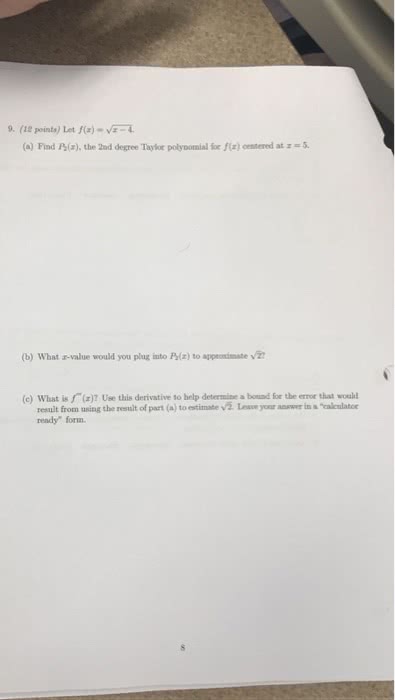
datuit
Jaypee University of Information Technology - JUIT
0 Followers
0 Following
4 Helped
I'm a new bie :vv
datuitLv3
13 Feb 2023
Answer: A. Latin American countries were economically dependent on Western cou...
datuitLv3
13 Feb 2023
Answer: The correct chronological order of these events is: Cuba goes to war a...
datuitLv3
13 Feb 2023
Answer: A a European country establishing a new colony in Latin America
datuitLv3
13 Feb 2023
Answer: yes
datuitLv3
13 Feb 2023
Answer:Trial 1: 15 mL Trial 2: 15 mL Trial 3: 15 mL
datuitLv3
10 Feb 2023
Answer: Islamic economics, also known as Islamic finance or Shari'ah-compliant...
datuitLv3
10 Feb 2023
Answer: Through the character of Winston Churchill, John Wright's film The Dar...
datuitLv3
10 Feb 2023
Buffer pH can be calculated using the Henderson-Hasselbalch equation. This is ...
datuitLv3
10 Feb 2023
Answer: The American Customary System of Units is widely used in the United St...
datuitLv3
10 Feb 2023
Answer: Familiarity: The American Customary System of Units is widely used in ...
datuitLv3
10 Feb 2023
Answer: In the previous session, 11/22 of the dogs passed Dennis' obedience cl...
datuitLv3
10 Feb 2023
Answer: C. Red
datuitLv3
10 Feb 2023
Answer: To convert (mpg) to (km/L), can use the conversion factor of 1 mpg = 0...
datuitLv3
10 Feb 2023
Answer: Without more information, it is not possible to determine how much mon...
datuitLv3
10 Feb 2023
Answer: B. linking verb
datuitLv3
9 Feb 2023
Answer: Large cash reserves: If a company has large cash reserves, it can miti...
datuitLv3
7 Feb 2023
Answer: In right triangle DEF, angle E is a right angle, DE = 8, and EF = 6. T...
datuitLv3
7 Feb 2023
Answer: The equation for the roots 3 and 3/4 would be: (x - 3)(x - 3/4) = 0 Ex...
datuitLv3
7 Feb 2023
Answer: -x + 3 = x^2 + 1 Extension on the right: -x + 3 = x^2 + 1 Solve for x:...
datuitLv3
7 Feb 2023
Answer: Globalization brings several benefits to individuals and societies, in...
datuitLv3
7 Feb 2023
Answer: (a) To find the 2nd degree Taylor polynomial, P_2 (z), we need to find...
datuitLv3
7 Feb 2023
Answer: The force can be calculated using Newton's second law of motion. force...
datuitLv3
7 Feb 2023
Answer: The basic components of a cell and their functions are: Nucleus: The n...
datuitLv3
7 Feb 2023
Answer: The results of visual and auditory vocabulary decision tasks analyzed ...
datuitLv3
7 Feb 2023
Answer: Fraud and abuse of Medicare and Medicaid insurance can have serious co...
datuitLv3
6 Feb 2023
Answer: f(x) = -5(x - 1)^2 + 5
datuitLv3
6 Feb 2023
Answer: Crossovers increase phenotypic variability within populations. At cros...
datuitLv3
6 Feb 2023
Answer: List the distances between each pair of genes.Beak color and tail feat...
datuitLv3
6 Feb 2023
Answer: Part 1 Punnett Square:| F | f---|-----|---f | Ff | fff | Ff | ffGenoty...
datuitLv3
6 Feb 2023
Answer: If y = x^2 - 4x + 4 and 2x - y = 1, then replace y = x^2 - 4x + 4 with...
datuitLv3
6 Feb 2023
Answer: From this information, we know that the quadratic function has a verte...
datuitLv3
6 Feb 2023
Answer: C) y = -3x - 6
datuitLv3
6 Feb 2023
Answer: It refers to a chemical reaction in which a 16e metal hydride acts as ...
datuitLv3
6 Feb 2023
Answer: One way children's language production reflects the language world is ...
datuitLv3
6 Feb 2023
Answer: Transcribe the adult production of the word IPA.a) Tent: [tɛnt]b) Hand...
datuitLv3
6 Feb 2023
Answer: P0 = D / (r - g) where:P0 is the current stock priceD is the dividendr...
datuitLv3
6 Feb 2023
Answer: In this case the composite function is f(u,v) = u + v + uv^2 and u = e...
datuitLv3
6 Feb 2023
Answer: Drawing conclusions based on subjective, holistic perceptions is unsci...
datuitLv3
6 Feb 2023
Answer: Solving for x gives: 2x - 3 = 9k-x + 4 = 3k Dividing both sides of the...
datuitLv3
6 Feb 2023
Answer: A. To calculate the flow rate in ml/h, the total volume of solution (2...

